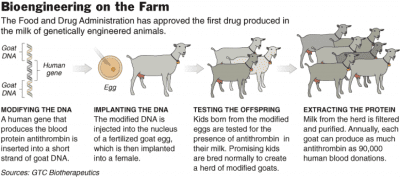Many pharmaceutical drugs in the form of complex proteins require 3D structures that are important for their functions. Animal cells have the unique machinery to make the special structures. Genetically engineered (transgenic, GMO) animals/animal cells are created so they serve as “bioreactors” to produce these drugs at an industrial scale. Animal products such as milk, egg white, blood, urine, and silk worm cocoons have been used to produce complex drugs that can’t be made by chemical synthesis. The first drug produced by GMO animals, anti-thrombin III from the milk of transgenic goats, prevents the formation of small blood clots that could break loose and plug other vessels (Figure 1). It was approved by the FDA in 2009. Animal cells and simple bacteria, however, have been used to produce protein drugs much earlier than that. For example, Activase® (r-tPA), produced by cells from Chinese hamsters, was approved by the FDA to treat stroke since 2001. The first bacteria produced drug, Humulin (human insulin) from Eli Lilly has been used by millions if not billions since 1982. Today, many cancer drugs such as monoclonal antibody therapeutics are produced by animal cell cultures after human genes are introduced to these cells. Pharmaceuticals from GMO animals/GMO cells/GMO bacteria will continue to be developed to save lives.

By Xiuchun (Cindy) Tian, Professor, UConn Department of Animal Science
Published November 9, 2017